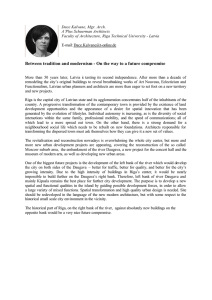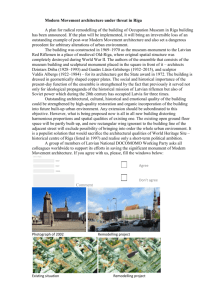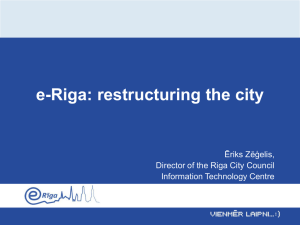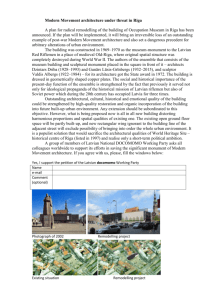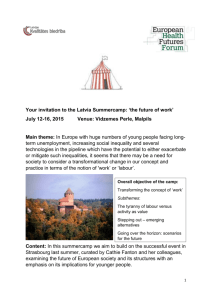ERASMUS INTENSIVE LANGUAGE COURSES
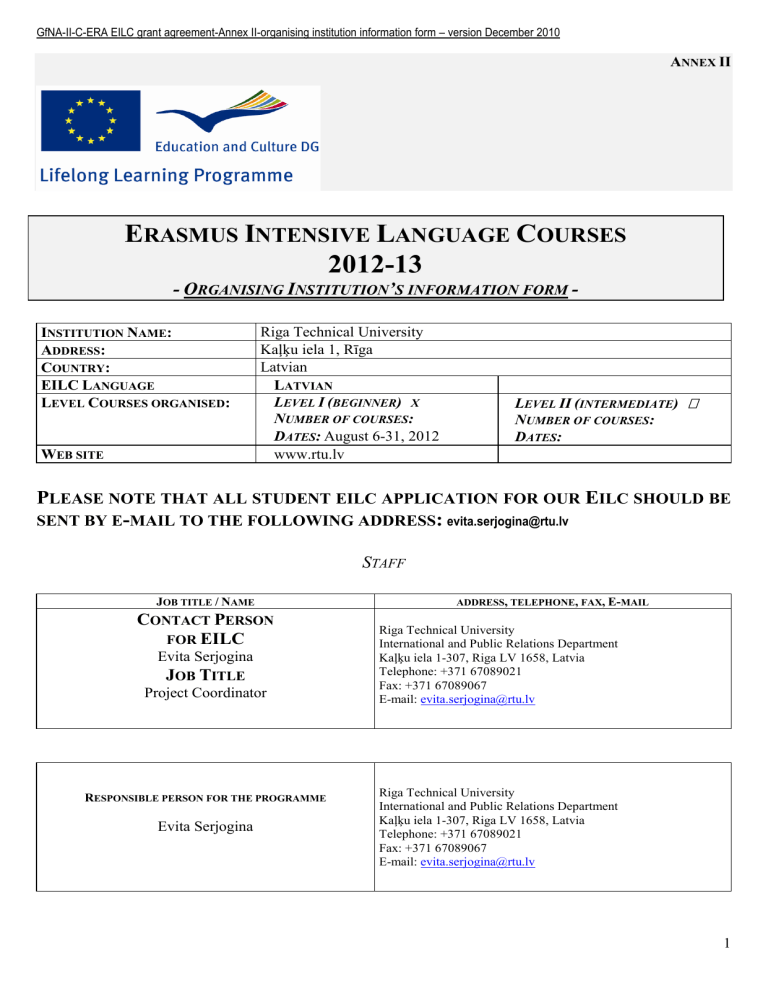
GfNA-II-C-ERA EILC grant agreement-Annex II-organising institution information form – version December 2010
A
NNEX
II
E
RASMUS
I
NTENSIVE
L
ANGUAGE
C
OURSES
2012-13
O
RGANISING
I
NSTITUTION
’
S INFORMATION FORM
-
I
NSTITUTION
N
AME
:
A DDRESS :
C
OUNTRY
:
EILC L
ANGUAGE
L EVEL C OURSES ORGANISED :
Riga Technical University
Kaļķu iela 1, Rīga
Latvian
L
ATVIAN
L
EVEL
I (
BEGINNER
)
X
N
UMBER OF COURSES
:
D
ATES
: August 6-31, 2012 www.rtu.lv
L
EVEL
II (
INTERMEDIATE
)
N
UMBER OF COURSES
:
D
ATES
:
W EB SITE
P
LEASE NOTE THAT ALL STUDENT EILC APPLICATION FOR OUR
E
ILC SHOULD BE
SENT BY E
-
MAIL TO THE FOLLOWING ADDRESS
:
evita.serjogina@rtu.lv
S TAFF
J OB TITLE / N AME
C
ONTACT
P
ERSON
FOR
EILC
Evita Serjogina
J
OB
T
ITLE
Project Coordinator
ADDRESS , TELEPHONE , FAX , EMAIL
Riga Technical University
International and Public Relations Department
Kaļķu iela 1-307, Riga LV 1658, Latvia
Telephone: +371 67089021
Fax: +371 67089067
E-mail: evita.serjogina@rtu.lv
R ESPONSIBLE PERSON FOR THE PROGRAMME
Evita Serjogina
Riga Technical University
International and Public Relations Department
Kaļķu iela 1-307, Riga LV 1658, Latvia
Telephone: +371 67089021
Fax: +371 67089067
E-mail: evita.serjogina@rtu.lv
1
GfNA-II-C-ERA EILC grant agreement-Annex II-organising institution information form – version December 2010
P ART I: G
ENERAL
I
NFORMATION
D
ESCRIPTION OF TOWN
S HORT HISTORY AND LOCATION
Riga, the capital city of Latvia, can be considered the heart of the Baltic region and is a typical North European medieval town . Riga has always been a multicultural city, as evidenced in the colourful, ethnic mosaic of its 700 000 inhabitants and has served as a crossroads from the moment of its foundation, as a bridge between the East and the West. This multinational aspect of Latvia's capital city has to a great extent been determined by the presence of water, namely, the Daugava River, which flows into the nearby
Gulf of Riga and the Baltic Sea. The natural terrain of this area is a flat and sandy plain, about 1 to 10 meters above the sea level.
With the help of crusaders, the German bishop Albert subjugated the indigenous population and is credited with the founding of
Riga. Riga became a member of the Hanseatic League and developed as a dynamic trading town until the 16th century. However, its strategic position between East and West has always kept Riga in the sights of its neighbours. Thus Riga has been under German,
Polish, Swedish and Russian rule for shorter or longer periods.
In the second half of the 19th century Riga began to be transformed from a bustling harbour town into a modern European town. It was a time of rapid economic progress that continued right up to the First World War.
In 1918 Riga became the capital of the newly independent Latvia. During 1920-1930 Riga developed into the centre of trade, light and food industries, as well as an important cultural and educational centre.
After the World War II Riga became one of the biggest centres of the western part of the Soviet Union, where according to the industrialization plans both light industry and significant enterprises of the military industrial complex were developed. Riga became also the centre of the Baltic military district. In order to provide the newly built enterprises with manpower, extensive immigration from other Soviet republics started. As a result, the number of the inhabitants in Riga increased by seven times from 1950 till 1980.
Restoring Latvia’s sovereignty, Riga became the centre of the Awakening Movement.
Today, the most colourful examples of Riga's multi-faceted nature lie in its architecture and culture. Riga is a vital, simultaneously ancient and modern city with new inspiration and energy. Part of Riga's appeal lies in its diversity. Thanks to its compactness, one can reach a different part of the city, reflecting a different ambience and sometimes also even a different era, within 20 minutes. In the narrow streets of the Old Town one has the feeling of having travelled in time, and returned to the previous centuries. Riga is the world capital of art nouveau architecture and has the highest concentration of wooden architecture among European capitals. Each generation creates Riga anew and the legend says that Riga will never be finished.
M AIN LOCAL / CULTURAL EVENTS
Riga is a lively city, especially in summertime, when it never falls asleep. It may impress you not only with its architectural peculiarities of the Old Town, but also offers a big variety of leisure time activities for young people. Countless cafes and bars, nice parks, concert and exhibition halls and its proximity to the Baltic Sea offer you endless opportunities for an exciting stay. There is always something happening in Riga - operas, concerts, theatre performances, design festivals, art exhibitions, DJ/VJ parties and other interesting events. The biggest cultural event in August is Riga City Festival 2012 (www.rigassvetki.lv).
2
GfNA-II-C-ERA EILC grant agreement-Annex II-organising institution information form – version December 2010
H OW TO REACH TOWN ( LINKS FROM THE NEAREST AIRPORT , TRAIN OR COACH STATIONS )
Bus No.22 has direct services between the airport and the city centre. You will get out straight at the terminal on the 2nd level. To get on the bus at the airport look for bus stop located opposite the terminal behind the car park P1.
Frequency 10 - 30 minutes, journey time to city centre about 30 minutes. A ticket for an unlimited number of trips is valid 24 hours from its first usage costs LVL 1.90. A regular ticket for one trip can be bought from the bus driver (price LVL 0.70), but if you buy it before commencing your trip at the airport services and tourism information bureau "Welcome to Riga", a regular one-way ticket will cost you only LVL 0.50. Additional information on bus lines and schedules at www.rigassatiksme.lv
. Toll-free information:
(+371) 8 000 19 19.
You can also travel from the airport to the city centre “Airport Express” minibuses.
The price for a ride is LVL 3 or EUR 5.
Payments are accepted in cash (lats only) or by a payment card. No extra charge for luggage. For more information please visit www.airbaltic.lv
A taxi can take you to the centre in 15-20 minutes. Charge is about LVL 1,50 plus LVL 0,50 per kilometre.
The central train station is located in the centre of Riga - about 5-10 minutes walking distance from the old town. The bus terminal is also situated in the centre, next to the train station. The ferry terminal is ca. 1,5 km away from the centre of Riga. Take tram Nr. 5, 7 or 9 and go two stops to the Old Town. The tram stop is situated on Ausekla street right in front of the terminal.
T RANSPORT IN TOWN ( BRIEF INFORMATION ON THE MAIN MEANS OF TRANSPORT AVAILABLE )
Public transport system in Riga consists of buses, trams and trolley buses. They run daily from 5:30 a.m. till approximately 11:30 p.m. Some routes have a night service every hour. There are smart tickets for 5, 10 and 20 trips, 24-hour, 3-day and 5-day tickets for one or several types of transport, as well as two-way tickets for groups of 2 or 3 persons. The price of one trip in
Rīgas satiksme public transport is LVL 0,70. It is more advantageous to buy 5, 10 or 20 trips at once. The price of ticket for five trips is LVL 2,50, for ten trips is LVL 4.75, but 20 trips - LVL 9.00.
More detailed information about public transport system in Riga you can find on the webpage www.rigassatiksme.lv
Toll-free information phone of Rīgas satiksme: +371 80001919; +371 1189 – information phone for timetables.
3
GfNA-II-C-ERA EILC grant agreement-Annex II-organising institution information form – version December 2010
S
HORT
D
ESCRIPTION OF THE
O
RGANISING
I
NSTITUTION
History of Riga Technical University (RTU) dates back to 1862 when Riga Polytechnic was founded. Today RTU is an accredited internationally recognised European university that consists of 8 faculties: Faculty of Architecture and Urban Planning, Faculty of
Engineering Economics and Management, Faculty of Civil Engineering, Faculty of Computer Science and Information Technology,
Faculty of Power and Electrical Engineering, Faculty of Electronics and Telecommunications, Faculty of Materials Science and
Applied Chemistry, Faculty of Transport and Mechanical Engineering,
including 33 institutes, which provide both full-time and part-time (evening and extramural) studies. Two independent institutes: Institute of Applied Linguistics and Institute of
Humanities, Riga Business School as well as affiliations in Daugavpils, Liepaja, Cesis and Ventspils, take an active part in the study process.
RTU is the second largest university in Latvia by number of students, and it has the greatest number of state funded students.
More than 200 agreements on cooperation have been signed with European and other foreign universities. RTU collaborates with the enterprises in major industries in Latvia and abroad as well as with state and local government institutions. Supported by European
Structural Funds, RTU is taking part in various research projects as well as in establishing of Competence Centres and National
Research Centres.
The implementation of RTU Development Project has started: construction of a single university campus «RTU – a City within the
City» is underway at Kipsala, Riga. The Project envisages setting up one of the most advanced engineering study centres in the
Baltic region thus providing students, researchers and industry representatives with up-to-date research opportunities and infrastructure.
The International and Public Relations Department of RTU gives students an opportunity to improve their language skills and become competitive candidates in the selection process for being included on different exchange programmes. The Riga Technical
University has been involved in the Erasmus Intensive Language Course Programme for exchange students already for more than ten years.
A
CCOMMODATION
SHORT DESCRIPTION OF THE ACCOMMODATION OFFERED ( HOTEL , APARTMENTS , STUDENT HALLS , OTHERS ; IF THERE ARE
COOKING FACILITIES ) AND ON THE RENT TO BE PAID PER WEEK
Students are housed in the dormitory of Riga Technical University located in Teika (see the location on the map: http://www.rtu.lv/en/content/view/2173/1283/lang,en/).
There are single rooms as well as double or triple rooms. Linen, blankets and pillows are provided. All tenants have access to a kitchen (crockery and cutlery - pots & pans are provided). The price for the dormitory is around LVL 90 to 120 per month.
M
EALS
SHORT DESCRIPTION ON THE SERVICES OFFERED ( UNIVERSITY CANTEENS , RESTAURANTS , BARS , OTHERS )
Riga Technical University has a canteen offering meals ranging from LVL 0.50 to LVL 2. Several main courses, sides and vegetarian options are available each day from 9 to 18. The University is located in the centre of the Old Town and there is a great variety of cafes, bars and restaurants in a short walking distance from RTU.
4
GfNA-II-C-ERA EILC grant agreement-Annex II-organising institution information form – version December 2010
RECEPTION OF STUDENTS
M EETING POINT ( PLACE , DATE AND TIME OF FIRST MEETING FOR EACH COURSE WHERE DIFFERENT )
Before arrival in Riga the students receive by e-mail practical information and the description of the easiest way of reaching the city centre and the dormitory. Pick-up service is organised involving local students as buddies for course participants. The first meeting is held on the first course day in Riga Technical University. Short orientation programme is offered as well.
EXTRA MURAL ACTIVITIES
S ITE VISITS
Site visits help you discover Riga’s diversity – from its classic attractions to the lesser-known gems on its outskirts and the wellhidden spots as well. Old Town – the truly heart of Riga. The narrow streets, warehouses from Middle Ages, dwelling houses and numerous churches, museums. Art nouveau (Jugendstil) architecture. Pārdaugava – life on the other bank of the Daugava River.
Wooden architecture of the 19 th
century. Ethnographic open-air museum – authentic houses, farmsteads, windmills, wooden churches, and fishermen's villages that represent different regions of Latvia in the 16 th
– 19 th
centuries.
The "Latvian Rivera" – Jūrmala is the famous spa-town 25 km from Riga and stretches along the coast of the Baltic Sea. The attractions of Jūrmala are its natural treasures and combination of charming wooden houses built in the beginning of the last century and modern resort buildings.
The picturesque town Sigulda is located in the valley of the Gauja River. Hilly river banks, caves in sandstone, ruins of the medieval castles make this town so unique.
Cēsis - city, which brings the past to life. There are artisans who practise their ancient skills in Cēsis and they even let every visitor try his hand. The master of the knights himself, from the 16th century, guides round his castle.
Pedvāle, an open–air museum, where you can see the harmony of art and nature.
S PORTS FACILITIES (S WIMMING , T ENNIS , G YMNASIUM ; OPENING DAYS AND AVAILABLE INFORMATION )
Sports events at the Riga Technical University are organised by the Department of Physical Education and the University Sports
Club. During the study period foreign students may participate in any of the sports activities of local students. RTU has the following athletic facilities:
an indoor pool (8 lines x 50 m)
outdoor tennis courts and an indoor tennis facility
a sports centre with a weight-lifting facility and a table tennis gym
a summertime seaside sports and recreation centre “Ronīši”.
E NTERTAINMENT (C INEMA , T HEATRE , ETC .; BRIEF INFORMATION ON PLACES AND STUDENT FACILITIES )
On the students request basis there is a plenty of possible entertainment activities. Depending on the interests and wishes of the students and the level of their Latvian language proficiency, visits to the theatre, cinema, concerts and different other kinds of entertainment will be organised.
5
Note: where more than one course is organised at each level, this form should be copied and completed for each course
P ART II: C
OURSE
(
S
)
DESCRIPTION
C
OURSE NO
:
LEVEL
:
I: Beginner course
II: Intermediate course
P ERIOD :
x
F ROM ...
6 August 2012
T O ...
31 August 2012
L
ANGUAGE COMPONENT
S HORT D ESCRIPTION OF LANGUAGE COMPONENT : OBJECTIVES AND TEACHING METHODS
The course is based on interactive didactic units in which lexical and grammatical elements will be combined.
The purpose of the course is to give basic knowledge of the Latvian language, to acquire everyday vocabulary in order to communicate in everyday situations, to learn to understand what is heard or read. Therefore especially oral communicative competence will be in the focus.
Materials with an emphasis on cultural diversities help students to get familiar with the Latvian culture, history and traditions.
Using communicative language teaching methods by the end of the language training course students will understand and speak a varying amount of the Latvian language studied within each of the following competencies: interpersonal, relationship, family, food, money, shopping, time, transport, etc.
Methodologies in language sessions include, but are not limited to: task-based learning, backward build-up, information’s-gaps, dialogues, repetitions, drills, role-play, simulations, games and songs. Students will have possibility to have language practice in shops, post office, bars, museums etc..
- SUBJECT SPECIFIC LANGUAGE ELEMENTS
(e.g. special modules for students in particular disciplines)
I F Y ES , SPECIFY :
- D URATION
T OTAL NUMBER OF CLASSES
H OURS IN CLASSROOM
H OURS OF PRACTICE CONVERSATION / LANGUAGE LABORATORY
OTHER ( PLEASE SPECIFY )
YES X NO
120h.
90h.
30h.
Lectures, site visits, excursions and other activities to get familiar with Latvian culture and traditions and situation in Latvia.
6
Note: where more than one course is organised at each level, this form should be copied and completed for each course
ASSESSMENT ( SPECIFY IF THE ASSESSMENT IS MADE BY WRITTEN / ORAL EXAMINATION , ASSIGNMENT , ETC .)
Students can measure their improvement day to day. Once a week there is a review and short test on done study material. At the end of the course students do the test consisting of: reading, listening, writing and an interview. Upon successful completion of the course each student will receive a Certificate on Further Education and 6 ECTS.
C
OURSE FACILITIES
- T EACHING AIDS
X AUDIO / VIDEO MATERIALS
X COMPUTER / SOFTWARE
X HANDOUTS / PRINTED TEXTS
X TRANSPARENCIES
OTHER : ( SPECIFY )
- L IBRARY
IF YES , SPECIFY :
TIMES
OPENING DAYS
ADDRESS
YES X NO
From 10:00 to 18:00
In August Tuesdays and Thursdays
Ķīpsalas iela 10, Riga LV 1659, http://www.zb.rtu.lv
L ANGUAGE LABORATORY
IF YES , SPECIFY :
TIMES
OPENING DAYS
ADDRESS
COST
YES
NO X
C
ULTURAL COMPONENT
- S HORT DESCRIPTION OF THE CULTURAL ELEMENTS INCLUDED IN THE COURSE : OBJECTIVES AND TEACHING METHODS
Understanding about language, formal and informal speech (greeting forms, polite requests, and phrases), lectures and discussions about Latvian history, films, folk and pop music, contemporary culture, intercultural training are essential components of the course.
The University is situated in the Old Town and it is surrounded by a number of museums, art galleries, concert halls, churches, theatres, music clubs, and Latvian-food restaurants. Visits to these places are integrated in the course programme, as well as Latvian film nigh, Latvian folk party, National evening etc..
- D URATION
T OTAL HOURS OF ACTIVITIES
T
EACHERS AND SUPPORT STAFF
T EACHERS
ADMINISTRATORS
S TUDENTS
N UMBER OF :
2
1
10
20h.
7
Note: where more than one course is organised at each level, this form should be copied and completed for each course
